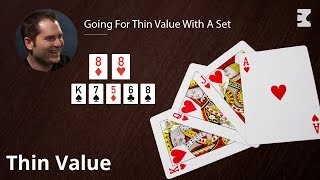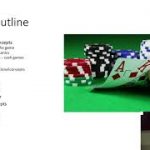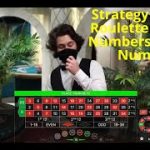Poker Strategy Info And Source:
In this hand the river gives us a set but also brings in the flush and a four straight. Should we bet for value and for what size?
If you want to call in with a hand or question for Bart use the number 3233481281. The show streams live each Monday at 4:45 P.M. PT. right here at youtube.com/c/crushlivepoker. To keep updated of schedule changes to the live stream follow @crushlivepoker on twitter.
To get the best in live poker training check out CrushLivePoker.com. Use the code YTA100 for the first month free.
Source: YouTube








Great review and pretty well played by the hero IMO
From the perspective of the villain, if I face an overbet I never call with worse than a 4 for the bottom straight. Even that might be a marginal call and I expect to lose to a higher straight or flush. If I had a King I might call half pot.
The overbet actually turns out to be a bluff since you have a decent chance of folding out some 4's. They're never calling with worse.
Great player at a low stakes. Whoever you are keep it up.
Just to play devil’s advocate, let’s look at why we should bet QQ on the flop in this spot. One reason that sticks out to me is that we block half the combos of KQ (villain has 6 combos instead of 12), so it is less likely that he has a King.
Let’s analyze this further and give a reasonable SB overcalling range from a tight passive OMC. 22-JJ, suited broadways, A5s+, 54s-T9s, ATo+, KJo+, QJo. Some important notes are that I did not include K9s or KTo in his range, and kept AK, most suited Aces, and QJo. This could be wrong, but most “tight” preflop players realize that KTo is a trash hand, but man do they love that QJo. Hypothetically, if we knew Villain’s exact holdings within this range, our action should be as follows:
Bet when Villain has a pair worse than a King, a flush draw, a straight draw, or Ace high. We can make a case that it is better to check against Ace high so he could make a pair with his other hole card or to get value from Ace high on a later street. However, I prefer to bet to protect our equity and possibly get called by Ace high now.
JJ, TT, 99, 88, 66, 44, 33, 22, A5s-AQs, ATo-AQo, 98s, 87s, 76s, 65s, 54s, and 1 combo of spades for QJs, QTs, JTs, T9s. Total: 126 combos.
Check when Villain has an unpaired non-Ace hand, no draws, or a King or better.
AK, KQ, KJ, KTs, 77, 55, QJo, and 3 combos of non-spades for QJs, QTs, JTs, T9s. Total: 67 combos.
According to this analysis, we should bet 65% of time and check 35%. This of course is based on multiple assumptions, and will always change based on Villain’s preflop range. Also, I am only realizing now that I didn’t consider the third player acting behind us, so this analysis is only appropriate for a heads-up scenario.
That overbet is only getting called by a better hand…I don't see the point of it. I think something like 40-50% pot, and fold to a raise would make more sense….isn't your main objective to get called by a king, or TT, JJ, QQ ?
🎆Nice💥